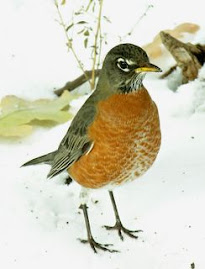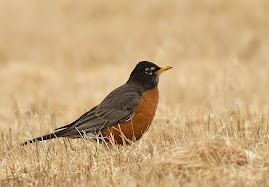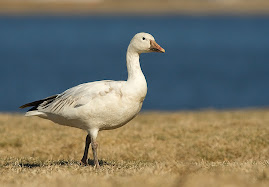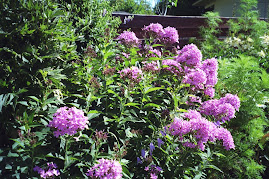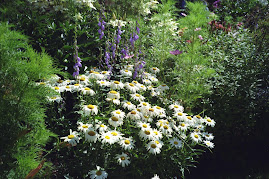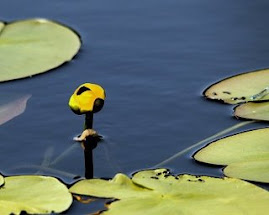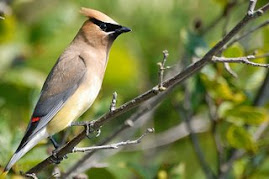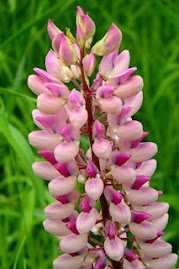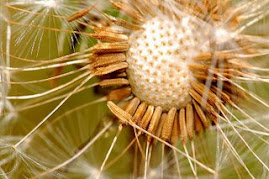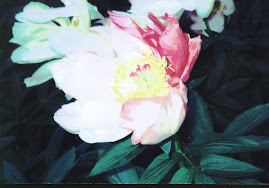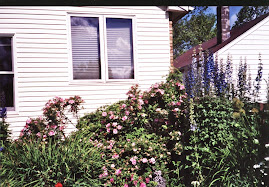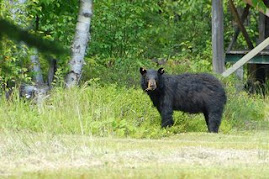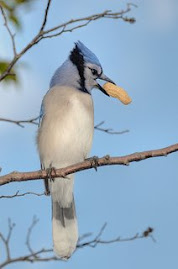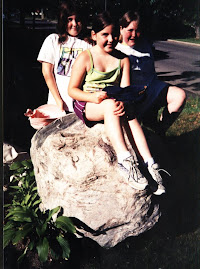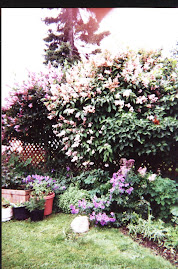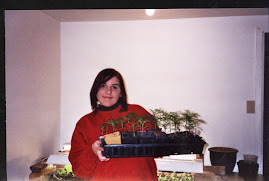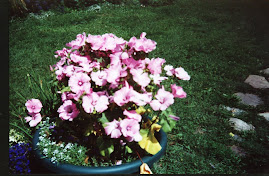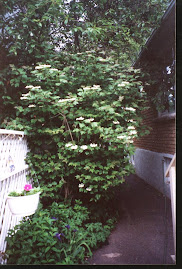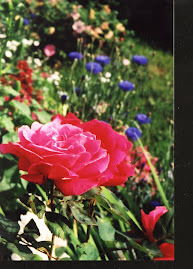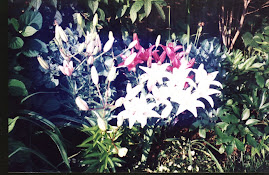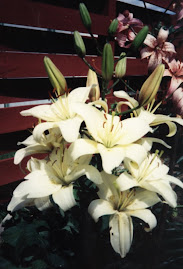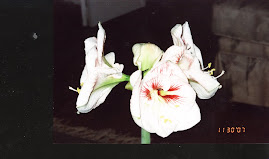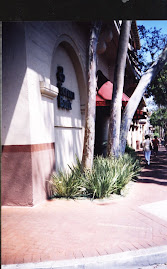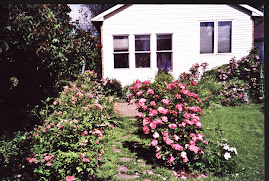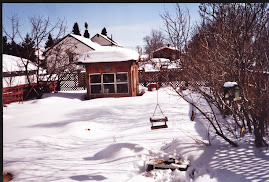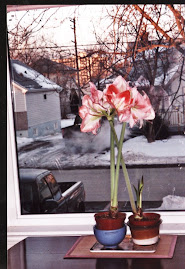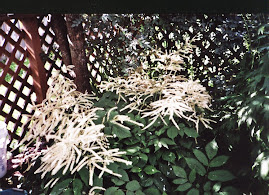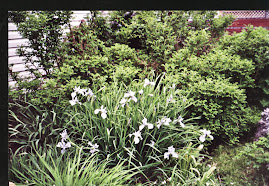From the corner of Balmoral and Central Avenue, turn west past Robins's and the car wash place. A little farther along, on the right side is the Central Natural Enviromental Garden, a nice place to stop and walk about or sit for a while. A picnic table provides one of the few places to eat a picnic in the inter-city area. There is a small parking area at the back.
A set of wild flower gardens unfurl under the willows, spruces, pines and two lovely small gold tamaracks. Even in the late fall, there is lots of interest as the natural plants hold out their seeds and the birds arrive.
Evening primrose, prairie sunflower, pearly everlasting, golden rod, dame's rocket, brown eyed susan, anise hysop, mullein, hawk weed (also called devil's paint brush), pinks, flax and other wild flowers are identified by well-made signs. This is a good place to check out the looks of the wild plants that you might want to use in your own garden.
I was interested to see a pile of wood chips at the back of the garden and note the use of wood chips between the groups of plants. Wood chips make a great weed repelling mulch, much more attractive and enviromentally friendly than plastic or weed barrier cloth. Also I some of the paths are just made of mown grass, a very nice way to create a path in a heavily planted garden.
Showing posts with label Wild flowers. Show all posts
Showing posts with label Wild flowers. Show all posts
Friday, 24 October 2008
Friday, 25 July 2008
This is the Key to the Kingdom
The Key to the Kingdom, says the old nursery rhyme, is a basket of flowers. And this month, all northwestern Ontario is a breathing basket of wild flowers.
On a recent trip to Rock Island Lodge outside of Wawa I saw sweeps, dreams, charms, floods of flowers along the roadside and in the deepest bush. I do not think, in a long northern life, I have ever experienced a season of such amplitude. I noted with pleasure, the towns of Wawa, Michipicoten and Rossport have not cut down all their wild flowers (as we do in Thunder Bay) but let them bloom in clumps here and there.
Lupines lead the way, swathes of them all along the highway. They were joined by:
· Ox eyed daisies
· Hawk weed (startling reddish orange)
· Mullein, tall fuzzy plants with a yellow stalk of bloom
· Evening primrose (tall with yellow blooms that open in the evening)
· Many varieties of wild pea and vetch
· Bunchberries (four petals, usually in shade)
· Wild strawberry flowers (very late this rainy year)
· Wild roses, some bushes laden
· High bush cranberry (white panicles of flowers)
· Saskatoons, choke cherry and pin cherry
· Wild honeysuckle (a small shrub with yellow flowers)
· Wild asters, white and blue
· Wood lilies, (Always a pleasant surprise)
· Wild iris or blue flags (all along the Michipicoten River)
· Harebells (purple ding-dongs)
· Twin flower (tiny double bells carpet deep bush)
· Queen Ann’s Lace
· Yarrow
· Cow Parsnip (our local giant up to eight feet tall)
· Meadow rue (white lace)
To name just a few. What a cornucopia! Thank you, goddess of the wild places.
Tip. If you visit Rossport, check out the garden at the Serendipity Café
On a recent trip to Rock Island Lodge outside of Wawa I saw sweeps, dreams, charms, floods of flowers along the roadside and in the deepest bush. I do not think, in a long northern life, I have ever experienced a season of such amplitude. I noted with pleasure, the towns of Wawa, Michipicoten and Rossport have not cut down all their wild flowers (as we do in Thunder Bay) but let them bloom in clumps here and there.
Lupines lead the way, swathes of them all along the highway. They were joined by:
· Ox eyed daisies
· Hawk weed (startling reddish orange)
· Mullein, tall fuzzy plants with a yellow stalk of bloom
· Evening primrose (tall with yellow blooms that open in the evening)
· Many varieties of wild pea and vetch
· Bunchberries (four petals, usually in shade)
· Wild strawberry flowers (very late this rainy year)
· Wild roses, some bushes laden
· High bush cranberry (white panicles of flowers)
· Saskatoons, choke cherry and pin cherry
· Wild honeysuckle (a small shrub with yellow flowers)
· Wild asters, white and blue
· Wood lilies, (Always a pleasant surprise)
· Wild iris or blue flags (all along the Michipicoten River)
· Harebells (purple ding-dongs)
· Twin flower (tiny double bells carpet deep bush)
· Queen Ann’s Lace
· Yarrow
· Cow Parsnip (our local giant up to eight feet tall)
· Meadow rue (white lace)
To name just a few. What a cornucopia! Thank you, goddess of the wild places.
Tip. If you visit Rossport, check out the garden at the Serendipity Café
Thursday, 3 April 2008
WILD FLOWERS TWO
The Wild Flower Garden – Two.
When I was growing up in the Port Arthur area, there were lots of wild flower gardens. They were called vacant lots. A lot of native species grew in these sunny grassy places: butter and eggs, black eyed susan, golden rod, yarrow, Joe Pye weed, mullein, pearly everlasting, various vetches and many others.
Of course there were also the travellers blown from near-by gardens. I remember finding a large rhubarb plant in one lot on Jean Street and in another, a lovely rose. Plants that we believe to be wild flowers but were introduced to the area long ago (example ox eye daisies) were abundant. We kids used to play in the long grass (today called “ornamental grass” in the seed catalogue) and found many small tiny flowers hiding there.
These vacant lots are all but gone and it is a treat to find one in town. I found a field of wild flowers on South Algoma Street two years ago, the site of the old Cornwall School. The native plants (and the introduced ones) had colonized the spot on their own and the number of birds was remarkable for such a small space. Native wild plants produce seeds acceptable to native wild birds. They also play host to native insects eaten by wild birds. Chipping and song sparrows sang on the day I walked though the area. I noted the plants were successfully breaking up the asphalt. “You go girls,” I said.
But alas. A letter to the newspaper demanded that these “weeds” be cut down. It is beyond my comprehension that a black eyed susan, sold in a local nursery, is a wild flower but when it grows wild it is a weed!
The city mowed the area to produce a field of stubble, for that is what you get when you mow wild grasses. It does not create turf. The song sparrow and the chipping sparrow decamped.
What I did not find in this vacant lot were the two “Toughies of Turf,” the dandelion and the plantain. These guys like mown lawn where they can spread their rosette of leaves, leaves so low the mower passes right over. Then, when no one is looking, they throw up a seed stalk and attempt to take over the world. They are very efficient plants. I believe that, in Thunder Bay, more money is spent on herbicides to attack dandelions and plantain than any other species of plant. Not only money but sweat and tears.
But the battle is pretty well over. The Ontario government, after hearing pleas from medical and environmental organizations, is planning to ban pesticides and that includes herbicides as well. Even after decades of war against the dandelion, the plant was never defeated and, after the ban on herbicides, its triumph is assured. So, Thunder Bay, time to get out grandma’s recipe book and learn how to make dandelion wine.
When I was growing up in the Port Arthur area, there were lots of wild flower gardens. They were called vacant lots. A lot of native species grew in these sunny grassy places: butter and eggs, black eyed susan, golden rod, yarrow, Joe Pye weed, mullein, pearly everlasting, various vetches and many others.
Of course there were also the travellers blown from near-by gardens. I remember finding a large rhubarb plant in one lot on Jean Street and in another, a lovely rose. Plants that we believe to be wild flowers but were introduced to the area long ago (example ox eye daisies) were abundant. We kids used to play in the long grass (today called “ornamental grass” in the seed catalogue) and found many small tiny flowers hiding there.
These vacant lots are all but gone and it is a treat to find one in town. I found a field of wild flowers on South Algoma Street two years ago, the site of the old Cornwall School. The native plants (and the introduced ones) had colonized the spot on their own and the number of birds was remarkable for such a small space. Native wild plants produce seeds acceptable to native wild birds. They also play host to native insects eaten by wild birds. Chipping and song sparrows sang on the day I walked though the area. I noted the plants were successfully breaking up the asphalt. “You go girls,” I said.
But alas. A letter to the newspaper demanded that these “weeds” be cut down. It is beyond my comprehension that a black eyed susan, sold in a local nursery, is a wild flower but when it grows wild it is a weed!
The city mowed the area to produce a field of stubble, for that is what you get when you mow wild grasses. It does not create turf. The song sparrow and the chipping sparrow decamped.
What I did not find in this vacant lot were the two “Toughies of Turf,” the dandelion and the plantain. These guys like mown lawn where they can spread their rosette of leaves, leaves so low the mower passes right over. Then, when no one is looking, they throw up a seed stalk and attempt to take over the world. They are very efficient plants. I believe that, in Thunder Bay, more money is spent on herbicides to attack dandelions and plantain than any other species of plant. Not only money but sweat and tears.
But the battle is pretty well over. The Ontario government, after hearing pleas from medical and environmental organizations, is planning to ban pesticides and that includes herbicides as well. Even after decades of war against the dandelion, the plant was never defeated and, after the ban on herbicides, its triumph is assured. So, Thunder Bay, time to get out grandma’s recipe book and learn how to make dandelion wine.
Subscribe to:
Posts (Atom)







